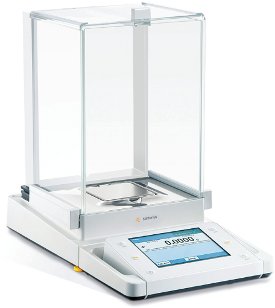A fundamental rule for using high-resolution balances in pharmaceutical laboratories is that the instrument be level at all times. If the lab balance is not level, it cannot accurately measure objects, and even the smallest tilt results in errors. When the balance is moved or shifted on a lab bench, even a slight incline can cause errors that quickly add up.
Checking whether a balance is level and correcting for any tilting is part of nearly every laboratory work flow standard operating procedure (SOP). The leveling procedure has long been considered a bothersome and timeconsuming task, and sometimes the effort is done perfunctorily. Now, automatic, motorized leveling features, like those found in the Cubis series of laboratory balances (Sartorius, Goettingen, Germany), provide accurate leveling, even in cleanroom environments where technicians wearing personal protective gear would otherwise find the leveling process difficult to accomplish. The Cubis laboratory balance is shown in Figure 1.
 Figure 1 – Cubis laboratory balance.
Figure 1 – Cubis laboratory balance.What is leveling and why is it so important?
A laboratory weighing instrument must be set up in the exact spot in which it will be used so that the force applied to the weighing pan when loaded is always parallel to the direction of gravitational acceleration. Operators test to ensure the balance is level and make any adjustments by using a level indicator with a bubble—a “spirit level” integrated into the balance. Leveling the balance must be done continuously in regulated areas, not just at the beginning of the workday. The adjustment procedure is time consuming; it takes practice to level a balance quickly. For this reason, users often only halfheartedly check whether the air bubble of the level indicator is actually properly centered.
It is so important that a laboratory balance be level because even the slightest tilt will result in potential errors. If the balance is not horizontal, it will not be able to correctly measure the weight of an object on its pan. When the balance is moved, even if it is shifted to a different position on the lab bench after cleaning, only a slight incline is all it takes to cause errors that quickly end up in the range of tolerances permissible for weights used in calibration.
In unfavorable conditions, such errors can even amount to several times established tolerances. These potential errors are unacceptable, especially when they occur during weighing of active pharmaceutical ingredients, and can thus be propagated in the sequence of the entire process chain.
Continuous monitoring with motorized leveling
As part of recent initiatives by the pharmaceutical industry to improve protection of people and products, balances are increasingly being operated under laboratory fumehoods and in safety weighing cabinets, safety workbenches, or laboratory gloveboxes. This trend is being driven by lab work performed using more powerful medications and combinations of Automatic Motorized Leveling of Laboratory Balances substances, as well as by new regulations, such as the EC Regulation concerning the Registration and Evaluation, Authorisation, and Restriction of Chemicals (REACH).
 Figure 2 – The Q-Level feature of the Cubis laboratory balance is accessible with the touch of a key.
Figure 2 – The Q-Level feature of the Cubis laboratory balance is accessible with the touch of a key.The trend also means that lab technicians are working under sterile conditions in cleanrooms, wearing such protective gear as laboratory goggles and double gloves, in addition to lab coats or cleanroom overalls. It is easy to see how a lab technician wearing several pairs of gloves would find it difficult to level the balance by attempting to turn its feet, especially considering that such a task exposes gloves to mechanical stress and may even tear them.
The difficulty of leveling the laboratory balance is even greater when it is operated inside a protective chamber within a contaminated area. The user’s view of the level indicator, which is already limited by the protective goggles, is additionally hampered by the glass or acrylic glass panel of the safety weighing cabinet or safety workbench. In this case, it is often near impossible to look directly at the level indicator to check the position of the bubble. When a user looks at the bubble from an angle, it results in incorrect adjustment due to the parallax shift between the air bubble and the marked target circle of the level indicator and, ultimately, errors in weight measurement results.
In response to these issues, Sartorius has developed automatic, motorized leveling as part of its Cubis series of laboratory balances. The balance’s Q-Level feature enables continuous monitoring along with automatic, motorized leveling with just a simple touch of the key (see Figure 2). A specially designed sensor and integrated motors remove the user’s need to visually check the level indicator and manually adjust the feet on the balance.
This works well even in what might be considered the most likely worst-case scenario, checking the level indicator and attempting to level a balance installed inside a glovebox. The Q-Level feature independently detects whenever a laboratory balance is not level and alerts the user accordingly. At the touch of a key, it then automatically levels the balance using the motorized leveling feet. For the user this means improved ergonomics; much faster system setup; and safer, more accurate weighing results.
Dr. Thomas Pertsch is Product Line Manager, Premium Balances, Sartorius, Lab Products and Services, Weender Landstr. 94-108, 37075 Goettingen, Germany; tel.: +49 551 308 3405; fax: +49 551 308 3289; e-mail: thomas.pertsch@ sartorius.com; www.sartorius.com